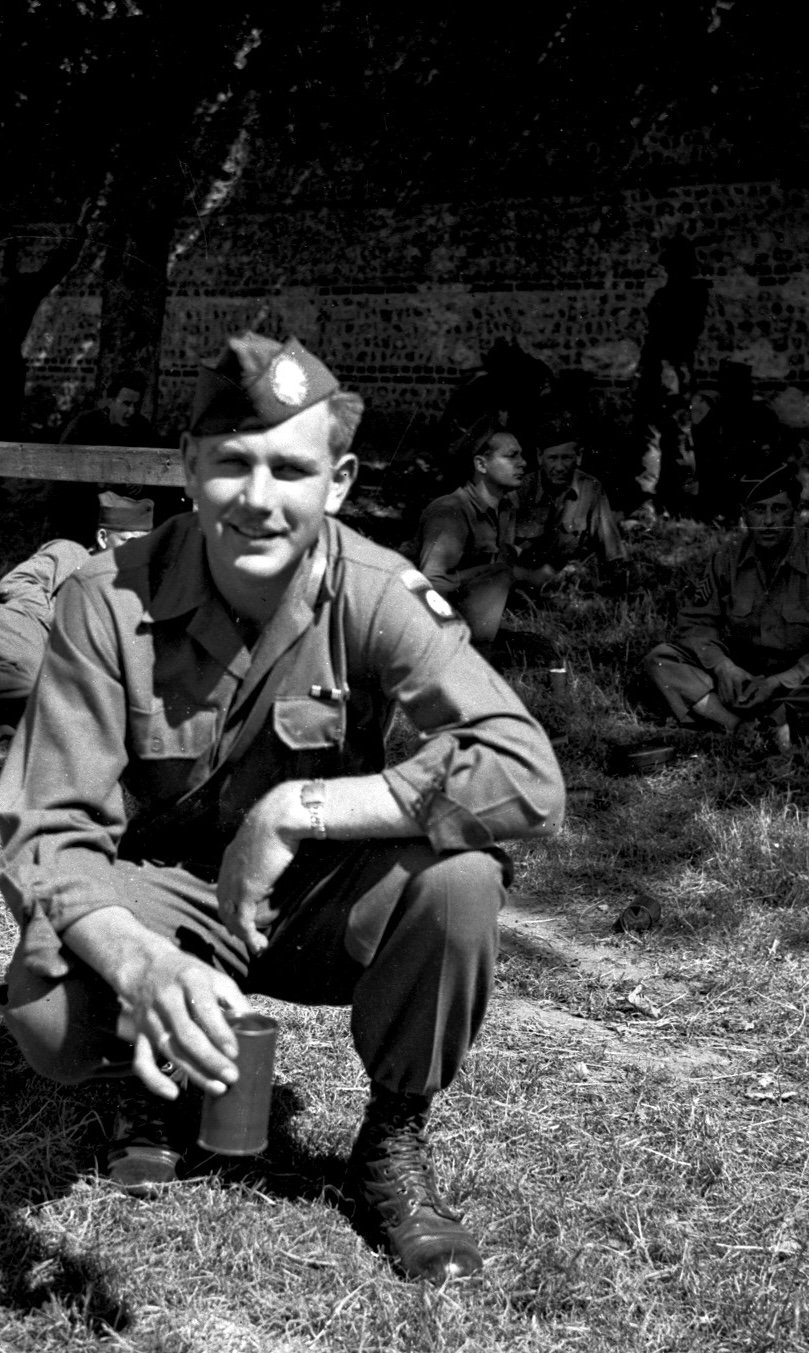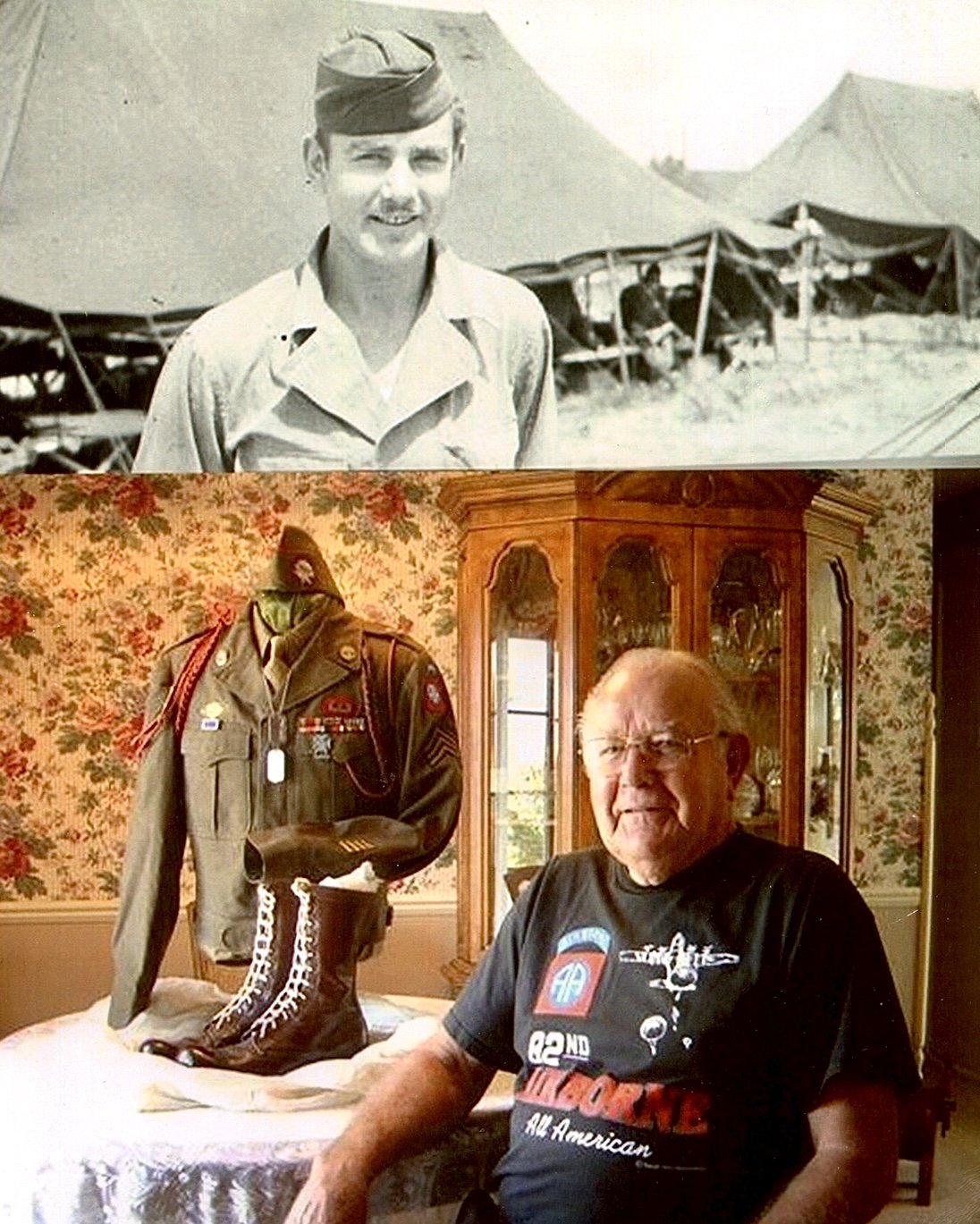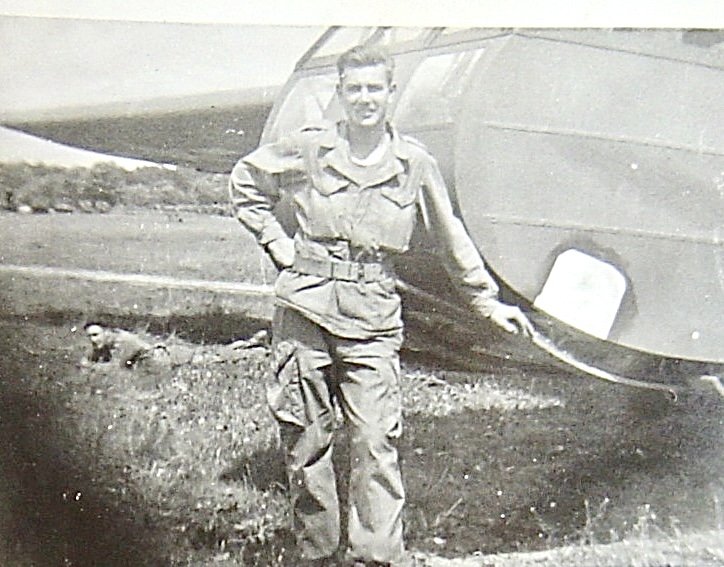Mahlon Sebring
ASN:36881639
Mahlon started his military "experience" so to speak at age 18 working at the B-24 bomber assembly plant in Willow Run, Michigan in 1942. The job he liked best was on final assembly working inside the bomber fuselage installing the hydraulic lines to the wheels, gun turrets, and flaps. At peak production, one fully completed bomber rolled off the assembly line every hour.
In September of 1943, Mahlon received his induction notice to report to Fort Custer in Battle Creek, Michigan. He declined a series of deferments he was entitled due to his war related work building B-24s. From Fort Custer, Mahlon was sent to Fort Bragg and assigned to an artillery replacement cycle. He received training on 155mm heavy artillery. After Fort Bragg and a brief stay at Fort George Meade, Maryland, it was on to Boston to catch a ship bound for England. Upon arrival, shortly thereafter, Mahlon was assigned as an artillery replacement to the 82nd Airborne Division, 319th Glider Field Artillery, A-Battery. There, he received training on the much smaller 75mm Pack Howitzer. Instead of being over 10 miles from the front lines, he was now just a few thousand yards.
Glider training began with the preparations for the Normandy Invasion. There was much training in loading, unloading, and securing supplies and vehicles while in flight. The gliders would be paired up, with the artillery piece in one while the other contained a jeep for towing it around. Ammo, supplies, and fuel were also stowed on board each glider. The two gliders would try to stay together and land near each other so the jeep and howitzer could be connected upon landing.
The D-Day invasion found Mahlon a passenger in a British Horsa glider. His particular glider crash landed near Ste. Mere Eglise shortly before 11:00 PM. The glider had struck trees upon landing in the dark and broke apart. There were no serious injuries except for cuts, bruises, and a few splinters even though the tail of his glider broke off and stayed hung up in the trees. It ended up the battalion was scattered all over and there was much chaos in the dark. The 319th was able to put a few jeep/howitzers combination's together to make an effective fighting force. They assisted 82nd Airborne infantry units with artillery support helping to prevent the Germans from reinforcing their beach positions and taking vital bridges and intersections for the Allied advance. Ste Mere Eglise was the first French city to be liberated from German occupation.
After D-Day, the unit returned to England in preparation for the Holland invasion. For “Market Garden”, Mahlon was told to take the co-pilot’s seat in his American made CG4A glider only because everyone knew of his bomber production experience. When Mahlon stated “Just because I built them doesn’t mean I know how to fly them,” the groups response was “You know more about airplanes than anyone else, get up there.” While inbound, the 350 foot nylon tow rope had a communication wire coiled around it and Mahlon was wearing the headphones so he could talk with the C-47 tow pilot. Once the Germans started throwing up heavy flak at the Dutch Coast, the C-47 increased its speed to the point where the glider airspeed indicator went into the red and the glider started shaking badly. Mahlon called the tow pilot telling him,”Slow down, you’re pulling us apart back here.” The pilot responded, "You're coming with us so hang on." About then, a flak shell exploded between the glider and the tow plane. A piece of shrapnel hit the nylon tow rope and it started to unwind. It held long enough until they were able to release and glide down to their designated landing area. Mahlon assisted the pilot in the landing and they all exited the CG4A glider quickly as the field was being raked with German machine gun fire. The enemy had recaptured the landing area from the earlier Paratrooper LZ and had to be driven back again. The incoming glider force and the paratroopers already on the ground were able to retake the landing zone. The 319th mission was to assist in the capture of the bridges at Grave and Nijmegen. The first few days on the ground where they landed near Groesbeek Holland had the 319th conducting firing missions in a 360 degree circle.
(L-R) - Donald Swanson, Ted Simpson, Mahlon Sebring, Joseph Tatreau and Herb Gost - ready at the Barkston Heath Airdome awaiting their glider mission into Holland
When the German offensive began in December 16, 1944, the 82nd Airborne, including the 319th Glider Field Artillery was sent to stop the thrust of the enemy known as the “Battle of the Bulge.” The 319th played a key role in stopping the advancing Panzer Divisions. Their orders were to pass through Bastogne and keep going until they met the Germans near Werbomont. The 319th had several different artillery positions and Mahlon remembers at one point seeing German tanks about 2 city blocks away advancing toward them. March order was given and they were able to pull out and safely re-locate. The Market Garden plan failed to achieve the final objective however substantial gains were made by the Allied forces.
The 319th crossed the Rhine River near Cologne. Mahlon still has vivid memories when the German 21st Army of 150,000 men surrendered to the 10,000 man 82nd Airborne Division in May of 1945. He will tell you he saw several stacks of German rifles propped against each other in piles 100 feet across. The surrender of an entire army to a single Division was unprecedented.
Standing (L-R) Thomas Ludwick, Orin Miller, Lloyd Cattell, Roland Gruebling, Mahlon Sebring - Kneeling (L-R) David Stelow, William Forsyth, Frederick Von Hassel, Staff Sgt. Thurman King Epinal, France - June 1945
The 319th advanced northward from Cologne into central Germany and eventually met the advancing Russian Army near the German city of Ludwigslust. It was there they discovered the Wobbelin Concentration Camp. Mahlon remembers the sickening smell coming from the camp. The horrific scene of dead prisoners everywhere was the reason the 82nd Airborne Command made the townsfolk bury some 200 bodies on the palace grounds of the Archduke of Mecklenburg as a lasting reminder of their inhumanity. When the German's finally surrendered, Mahlon’s unit was sent to Berlin for occupation duty in the American sector. While in Berlin, Mahlon toured the 1936 Olympic facilities and Reich Chancellery. He stood in Hitler’s office at his massive desk and saw the Furher Bunker being guarded by the Soviets.
Mahlon went to jump school in Berlin and became qualified when the rumor started the 82nd was going to be sent to the Pacific to fight the Japanese. Mahlon was promoted from PFC to Corporal in August of 1945 and again to Sergeant in November 1945.
Mahlon returned home on a Victory ship and upon passing the Statue of Liberty, was greeted by another ship that had on board a full orchestra playing tunes with Doris Day singing to the soldiers. Mahlon left New York City for Camp Atterbury, Indiana where his discharge was final January 3rd, 1946.
(slideshow, side controls to next image)















